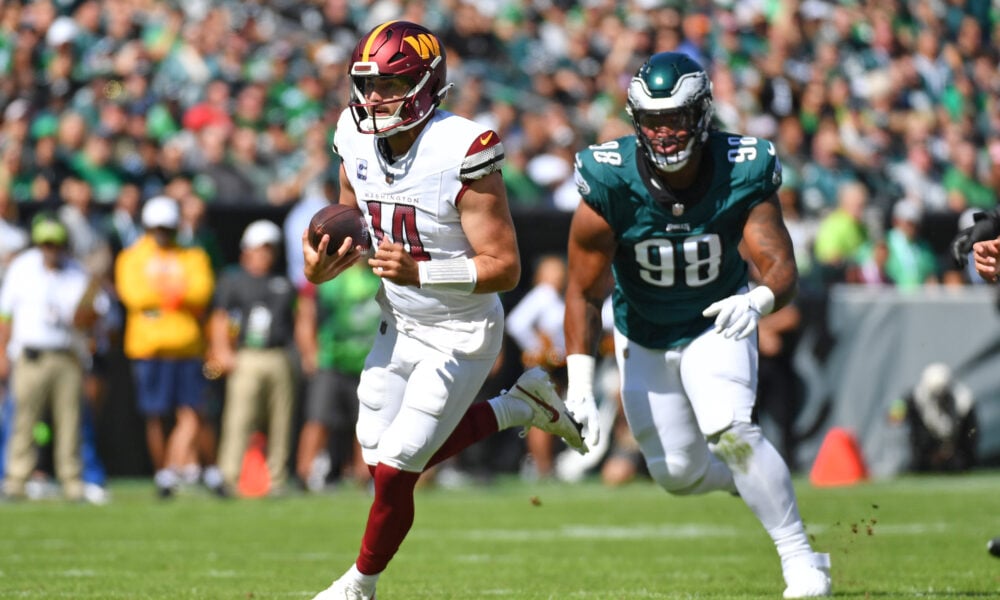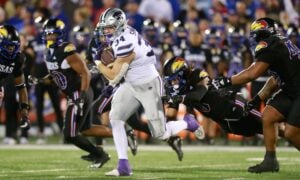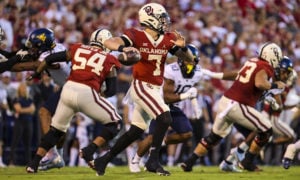2023 IDP Rookie Review: Interior Defensive Linemen

I started writing this annual rookie review series beginning with the 2020 draft class, and the interior defensive line hasn’t given us much to get excited about. Until now.
Sure, Carolina’s Derrick Brown and Baltimore’s Justin Madubuike – both from the 2020 draft class – have come around and developed into dynasty DT1s. And 2021’s top tackle, Christian Barmore of New England, rebounded this year from an abysmal 2022 to get back into the DT2 conversation.
But last season, with the Packers’ Devonte Wyatt representing the only tackle remotely resembling a fantasy asset, was the bottom. From a dynasty perspective we needed a class like this to replenish a position that is likely soon to lose longtime studs Aaron Donald and Cameron Heyward, especially with the 2024 rookie group lacking any elite-level standouts.
About the Series and Statistics
This is the first offering in this 2023 IDP rookie review series. Still to come are the edge rushers, linebackers, and finally safeties. The cornerback class was nice too but corners simply don’t carry dynasty value from year-to-year, so I don’t pay them much mind when looking through a dynasty lens.
Before getting into the rankings and brief reviews, credit goes to Pro Football Reference (PFR) for all statistics except for pressures, which come via Pro Football Focus (PFF). The “backfield disruption score” is quarterback hits plus tackles for loss, divided by snaps and multiplied by 100. (See the 2022 edge review for an explanation. I was referring to it as “plays in the backfield” at that time) If you want to see how this plays out at the interior defensive lineman position in 2023, the top ten (500 snaps minimum) looks like this:
- Justin Madubuike, BAL (5.95)
- Chris Jones, KC (5.68)
- Aaron Donald, LAR (4.51)
- Ed Oliver, BUF (4.11)
- Quinnen Williams, NYJ (3.99)
- Dexter Lawrence, NYG (3.95)
- Christian Barmore, NE (3.87)
- Zach Sieler, MIA (3.85)
- Calijah Kancey, TB (3.81)
- DeForest Buckner, IND (3.81)
Examples of players in the bottom ten include the the likes of the Patriots’ Lawrence Guy (0.19) and Davon Godchaux (0.44), Carolina nose Shy Tuttle (0.37), Kansas City’s Derrick Nnadi (0.40) and the Chargers’ Austin Johnson (0.47). These names shouldn’t surprise anyone.
One final note: I’m assuming the readers of this particular article are in defensive tackle-required and premium scoring formats: that is, defensive tackles get some sort of premium over other positions for statistics such as tackles, tackles in the backfield, and/or sacks. Only a small handful of these tackles have any value in leagues that just require general defensive linemen starters.
Tier One: Elite Assets
Quinnen Williams, Jeffery Simmons, Chris Jones, Dexter Lawrence and DeForest Buckner have some company in my elite tier of defensive tackles.
1. Jalen Carter, PHI
- Drafted: first round, ninth overall pick (Georgia)
- Listed height and weight: 6-3, 314
- Age prior to kickoff of 2024 season: 23
Stats to know:
- played in 16 games; 563 defensive snaps (51 percent snap share)
- 49 pressures; six sacks; nine quarterback hits; eight tackles for loss
- Backfield disruption score: 3.03
- 20 solo tackles, 13 assists; three missed tackles (8.3 percent missed tackle rate)
Coming out of Georgia, Carter was the most well-regarded pass rushing defensive tackle prospect of this century. His snaps and his effectiveness tailed off over the second half of 2023, but otherwise he didn’t disappoint as a first-year pro. His size, quick feet and hands, speed and power were all on display over the course of the season, and offensive linemen resorted to holding to give their quarterbacks time to escape the pocket or get rid of the ball (just watch the clips below).
.@Eagles @breadmanjalen has everything he needs to be as good as he wants. #BaldysBreakdowns pic.twitter.com/2h0wmkixFN
— Brian Baldinger (@BaldyNFL) November 21, 2023
Statistically, Carter had a very similar season to Green Bay’s second-year tackle, Devonte Wyatt, who is a full three years older than Carter. Youth can be a little overrated in dynasty, where three-year windows are about all you can really count on. In this case though, that age speaks to some undeveloped potential in focus and run defense. As it stands, Carter may never be a 75 percent snap share tackle given his shortcomings against the run, and that’s a concern for fantasy numbers. Regardless, Carter’s big play upside is week-winning stuff.
2. Calijah Kancey, TB
- Drafted: first round, No. 19 overall pick (Pittsburgh)
- Listed height and weight: 6-1, 281
- Age prior to kickoff of 2024 season: 23
Stats to know:
- played in 14 games; 577 defensive snaps (62 percent snap share)
- 34 pressures; four sacks; 12 quarterback hits; ten tackles for loss
- Backfield disruption score: 3.81 (ninth among all interior defensive linemen playing at least 500 defensive snaps)
- 19 solo tackles, seven assists; one missed tackle (3.7 percent missed tackle rate)
The Aaron Donald comparisons were lazy and unfair, but Kancey did prove to be an effective backfield disruptor as a rookie – in fact he was top ten in the NFL among regulars. The jump cuts, the arm movement and the explosive footwork are tough for any lineman to deal with one-on-one, and Kancey can make veterans look silly.
.@Buccaneers @Eagles @Ckancey8 was a dominant force in a dominant defensive effort. @Pitt_FB #playoffs #BaldysBreakdowns pic.twitter.com/3FsLyHS8gX
— Brian Baldinger (@BaldyNFL) January 16, 2024
Kancey really didn’t get going until week six after aggravating a pre-season calf injury in week one, but still logged more snaps than any rookie defensive tackle not named Kobie Turner. And though PFF graded Kancey extremely poorly as a run defender and as a tackler, I don’t think either grade is indicative of a poor player who is going to be a liability against the run in future seasons. As long as the Bucs can as a team cover the gaps left open when Kancey ghosts a guard, the value he brings as a threat to pocket integrity outweighs the downside.
Kancey also has the Relative Athletic Score we look for in our elite tiers of players. Despite very poor size scores, Kancey received a 9.60 RAS thanks to elite marks in all other available testing numbers.
Tier Two: Current or Future Fantasy Starters
This is a pretty loaded tier, with Christian Wilkins, Derrick Brown, Jonathan Allen, Aaron Donald, Ed Oliver, Justin Madubuike, Christian Barmore, Zach Allen, Zach Sieler and Javon Hargrave, plus a couple of rookies from this class.
3. Kobie Turner, LAR
- Drafted: third round, No. 89 overall pick (Wake Forest via Richmond)
- Listed height and weight: 6-2, 288
- Age prior to kickoff of 2024 season: 25
Stats to know:
- played in all 17 games; 697 defensive snaps (62 percent snap share)
- 48 pressures; nine sacks; 16 quarterback hits; eight tackles for loss
- Backfield disruption score: 3.45
- 29 solo tackles, 28 assists; five missed tackles (8.1 percent missed tackle rate)
This article is probably going to get a fair share of one-star ratings with Turner not in the elite tier. And I get it: Turner was second only to Kancey in backfield disruption. He was second (barely) to Carter in PFF pressures. He easily led all rookie tackles in tackles, and snaps. He’s good! I know. Nine-sacks-as-a-rookie good. But he produced sacks at an unsustainable rate, and he’s due for some regression.
Knowing sacks are a bit fluky, I generated a metric that combines PFF-provided quarterback hits and hurries (pressures minus the sacks), and turned it into a ratio based on the number of NFL-credited sacks (data from PFR). Turner (0.243) overachieved in the sack department similarly to Justin Madubuike (0.260). When comparing Turner to the most similar players from PFF’s pass rush win rate, backfield disruption score, and snaps, Turner has a much higher ratio of sacks generated than Jeffery Simmons (five and a half) and David Onyemata (four). Their respective sack ratios (0.134 and 0.138) are more in line with what we should expect to see from Turner right now, and if I had to place a wager on Turner’s sack total for 2024, I’d say it’s in the five to six range, which makes for a fine starter as long as the tackle numbers are respectable.
Keep in mind he’s also two years older than Carter and Kancey, and almost three years older than Bresee.
4. Bryan Bresee, NO
- Drafted: first round, No. 29 overall pick (Clemson)
- Listed height and weight: 6-5, 305
- Age prior to kickoff of 2024 season: 22 (turns 23 on October 6)
Stats to know:
- played in 17 games; 539 defensive snaps (49 percent snap share)
- 31 pressures; four-and-a-half sacks; nine quarterback hits; seven tackles for loss
- Backfield disruption score: 2.97
- 12 solo tackles, 12 assists; zero missed tackles
If Turner is at the higher end of this tier, Bresee would certainly be toward the bottom, as he’s still a bit of a projection as an all-around tackle. With an RAS of 9.60, Bresee came out of Clemson with size and explosion, capable of backfield disruption – especially against pass sets. His height and anchor worked against him vs. the run, and he needed to learn to play lower in order to win the leverage game against offensive linemen. In short, and in tribute to the late Dennis Green, he is who we thought he was.
All reports indicate a player who takes to coaching and is willing to put in the necessary work to improve, and I’m expecting a steady rise for Bresee over the next couple of seasons. He’s capable of some massive weeks – weeks four and 15 in 2023 were huge – but he’ll need a higher snap share and tackle totals to reach weekly DT2 status.
Tier Three: Worthy of a Roster Spot
There are enough reasons to like each of these defensive tackles that I’d deem them worthy of a roster spot in all-but-shallow league formats. In essence I’d like to see how they improve with a full NFL off-season before making a dynasty determination. In ten-team leagues or 12-team leagues that lump defensive linemen together or require just one defensive tackle starter, they’re probably just waiver wire guys worth keeping an eye on.
5. Gervon Dexter, CHI
- Drafted: second round, No. 53 overall pick (Florida)
- Listed height and weight: 6-6, 312
- Age prior to kickoff of 2024 season: 22 (turns 23 on October 5)
Stats to know:
- played in all 17 games; 432 defensive snaps (40 percent snap share)
- 29 pressures; two-and-a-half sacks; 12 quarterback hits; zero tackles for loss
- Backfield disruption score: 2.77
- 13 solo tackles, seven assists; two missed tackles (9.1 percent missed tackle rate)
Bears fans may always question the team’s decision to swap picks with the Eagles during the first round. Instead of nabbing Jalen Carter at No. 9, Chicago moved back one spot, selecting offensive tackle Darnell Wright and adding a 2024 fourth round pick. The Bears then doubled down on defensive tackle on day two, starting with Dexter at No. 53. Dexter’s development into a solid-to-good starter would go a good way toward easing the sting of seeing Carter in Philly green. Early indications are promising.
With a huge frame that looks capable of adding mass, Dexter has quick feet and a competitive nature that should allow him to round out his run game support. He’s already shown the ability to get into the backfield in pass sets, with 12 quarterback hits (tied for second among rookies with Kancey, behind only Turner – both played significantly more snaps) and a PFF pass rush win rate of 11.9 percent (equal to fellow rookie Tuli Tuipulotu). There’s probably not a lot of separation on the development curve and upside between Dexter and Bresee, and in 14- and 16-team formats with two defensive tackle starters, Dexter easily slides up to tier two.
6. Keeanu Benton, PIT
- Drafted: second round, No. 49 overall pick (Wisconsin)
- Listed height and weight: 6-4, 309
- Age prior to kickoff of 2024 season: 23
Stats to know:
- played in all 17 games; 484 defensive snaps (43 percent snap share)
- 22 pressures; one sack; eight quarterback hits; one tackle for loss
- Backfield disruption score: 1.86
- 16 solo tackles, 20 assists; three missed tackles (7.7 percent missed tackle rate)
You can make a good argument Benton would be a better dynasty asset on a different team, even though he’s perfectly suited as a Steeler. With size and a skillset that allows him to play any number of interior defensive line spots, Benton may be destined to play out as a better real-life contributor than in fantasy as long as he’s in Pittsburgh given snaps played at nose tackle (198) vs. the more advantageous 3-, 4- and 4i-techs (292).
Similar to Javon Hargrave, who spent his first four seasons in Pittsburgh playing a similar role, Benton’s share of time mining the A-gap vs. the B-gap isn’t as much a fantasy death knell as it is a lower ceiling on production. Hargrave gained fantasy value as he aged and spent less time at nose. The ultimate key in both cases is snap volume, which Benton should be primed to receive given Cam Heyward’s age and Pittsburgh’s lack of serviceable options thanks to draft busts including DeMarvin Leal and Isaiahh Loudermilk. With a more sure future than Dexter or Bresee – Benton is already good against the run and capable against the pass – your own personal ranking of the three likely depends on your appetite for risk vs. upside.
7. Karl Brooks, GB
- Drafted: sixth round, No. 179 overall pick (Bowling Green)
- Listed height and weight: 6-3, 296
- Age prior to kickoff of 2024 season: 24
Stats to know:
- played in all 17 games; 380 defensive snaps (34 percent snap share)
- 25 pressures; four sacks; five quarterback hits; six tackles for loss
- Backfield disruption score: 2.90
- 12 solo tackles, eight assists; one missed tackle (4.8 percent missed tackle rate)
Ultra-productive in college with 27.5 sacks in 52 games, Brooks left a lot to be desired with his athletic testing (5.87 RAS) and stubby 31.5-inch arms (hence the slide to the sixth round). I think the Pack got a steal though, as Brooks showcased an ability to cause problems for opposing linemen in one-on-one matchups. Case in point, check out this quick win against left guard Teven Jenkins in week 18:
It wasn't seen as a strong defensive linemen draft class. The #Packers got Karl Brooks in the sixth round. pic.twitter.com/IoqaWJAJPv
— Wendell Ferreira (@wendellfp) January 9, 2024
My guess is snap volume is always going to keep Brooks from becoming a consistent enough contributor to justify fantasy starts. But with Kenny Clark’s contract voiding after 2024, and given Brooks’ strong showing as a rookie, my guess may be off.
8. Adetomiwa Adebawore, IND
- Drafted: fourth round, No. 110 overall pick (Northwestern)
- Listed height and weight: 6-2, 282
- Age prior to kickoff of 2024 season: 23
Stats to know:
- played in ten games; 132 defensive snaps (19 percent snap share)
- six pressures; one-and-a-half sacks; four quarterback hits; one tackle for loss
- Backfield disruption score: 3.79
- four solo tackles, one assist; one missed tackle (16.7 percent missed tackle rate)
Adebawore burst onto the IDP scene during Senior Bowl week with explosive one-on-one wins in drills and impressive testing numbers and measurables. There was buzz that he could jump into round one of the draft. And then, reality happened. A project moving from college edge to professional 3-tech, Adebawore slipped to early day three. In season, he saw minimal work – certainly not enough to justify an opinion on much other than he’s a work in progress.
The upside based on athleticism keeps me interested in Adebawore. He’s a good stash in IDP leagues with ample taxi squad spots. Otherwise he’s probably in the watch list tier.
Tier Four: Watch List
If you’re in a 14- or 16-team league, or a league with a lot of roster spots and/or oversized taxi squads, you could consider rostering tackles in this tier based on draft capital or brief flashes in their rookie seasons. Otherwise you’re better off using your roster spots on other positions.
9. Dante Stills, ARI
- Drafted: sixth round, No. 213 overall pick (West Virginia)
- Listed height and weight: 6-4, 286
- Age prior to kickoff of 2024 season: 24
Stats to know:
- played in 15 games; 533 defensive snaps (54 percent snap share)
- 20 pressures; three-and-a-half sacks; five quarterback hits; five tackles for loss
- Backfield disruption score: 1.88
- 18 solo tackles, 29 assists; one missed tackle (2.1 percent missed tackle rate)
Stills finished third among rookie tackles in total fantasy points and points per game, but isn’t even rosterable in 12-team leagues? What gives?
Stills proved to be serviceable as a rookie but also had the benefit of playing in Arizona, where competition for snaps along the defensive interior line included the likes of Kevin Strong, Roy Lopez, Leki Fotu and Jonathan Ledbetter. If an opposing offensive line coach lost sleep preparing for this group, it was probably due to a late shot of caffeine.
Stills notched a sack and a half against the Ravens in week eight, and both occasions could be considered coverage sacks (Lamar Jackson held the ball for four seconds on one, and more than six seconds on the other). They count, but those types of sacks are not an indicator of a fantasy-worthy IDP. He proved he belongs in the league, but otherwise I’d expect Stills to see a reduction in snap share and production in 2024 and beyond.
10. Zacch Pickens, CHI
- Drafted: third round, No. 64 overall pick (South Carolina)
- Listed height and weight: 6-4, 300
- Age prior to kickoff of 2024 season: 24
Stats to know:
- played in all 17 games; 264 defensive snaps (25 percent snap share)
- eight pressures; half-a-sack; two quarterback hits; one tackle for loss
- Backfield disruption score: 1.14
- nine solo tackles, 11 assists; two missed tackles (9.1 percent missed tackle rate)
In retrospect I was too high on Pickens the prospect, as I considered him to be a better pass rusher than he ultimately proved to be. He was solid for a rookie but didn’t show anything special during the snaps he was given. Drafted just 11 picks after teammate Dexter, there’s a considerable gap in their dynasty values headed into year two. I’m still intrigued a little but I also realize he’s much more likely to settle into a lower-volume rotational role than a low-end fantasy starter.
11. Colby Wooden, GB
- Drafted: fourth round, No. 116 overall pick (Auburn)
- Listed height and weight: 6-4, 273
- Age prior to kickoff of 2024 season: 23
Stats to know:
- played in all 17 games; 255 defensive snaps (23 percent snap share)
- 11 pressures; half-a-sack; two quarterback hits; one tackle for loss
- Backfield disruption score: 1.17
- ten solo tackles, seven assists; one missed tackle (5.6 percent missed tackle rate)
Wooden carries a tackle designation but is very light for the role in Green Bay and is just as much a 4-tech or edge. Wooden has work to do breaking down blocks, and it’s reflected in his rookie season production. There’s enough appeal with the frame, length and lower body and hand/arm quickness to keep an eye on Wooden, but chances of him ever becoming a rosterable fantasy asset are slimmer than the filling in a knock-off Oreo.
Tier Five: Not Worth Watching
There’s nothing to see here for fantasy but given draft capital I wanted to mention these tackles.
12. Mazi Smith, DAL
- Drafted: first round, No. 26 overall pick (Michigan)
- Listed height and weight: 6-3, 337
- Age prior to kickoff of 2024 season: 23
Stats to know:
- played in all 17 games; 304 defensive snaps (28 percent snap share)
- eight pressures; one sack; three quarterback hits; three tackles for loss
- Backfield disruption score: 1.97
- nine solo tackles, four assists; two missed tackles (13.3 percent missed tackle rate)
Smith wasn’t bringing much to the table as a pass rusher as a prospect; his appeal came as a hold-the-point-of-attack, stack-and-shed run clogger. It’s a needed skill set in the NFL, but not so much in fantasy. PFF graded Smith out poorly vs. the run, so he’ll need some improvement to fill that role effectively.
13. Siaki Ika, CLE: Ika was fine as a third-round selection (No. 98 overall), but he was still a bit of a project given his out-of-control play style. He’s a big man who could eventually become a team’s primary nose tackle, but that’s a low-ceiling fantasy outlook.
14. Byron Young, LV: The Alabama product was a severe overreach as a mid-day two selection (third round, No. 70 overall). Young couldn’t crack 100 snaps on the season, failing to make an impact over the first seven weeks of the season. He was inactive from week eight on.
15. Brodric Martin, DET: A sixth-year senior (i.e., older) prospect, Martin, like Young, was a bad reach as a third-round selection. He’s a rotational nose tackle with zero fantasy value.
- Dynasty Rookie IDPs in the NFL Draft: Day One Review - April 26, 2024
- Positional Strengths of the NFL Draft: IDP Edition - April 23, 2024
- 2023 IDP Rookie Review: Safeties - March 13, 2024


































































